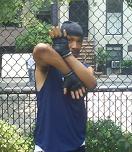|
Jailhouse Rock is also known as
'52 blocks' first came to public attention in the late 1990s, thanks to
Douglas Century, author of the book Street Kingdom: Five Years Inside the
Franklin Avenue Posse. In the book, Century describes his friendship, over
the course of a few years, with a former criminal and would-be rap star
named Big K. |
 |
|
It is in this profanity-laced narrative, in
which the identities of those involved are disguised with aliases, that 52
Blocks or “Jailhouse Rock” is described. Century followed this up in August,
2001 with a feature article in Details magazine called “Ghetto Blasters:
Born in prison, raised in the ‘hood, the deadly art of 52 Blocks is
Brooklyn’s baddest secret.” The style was also profiled in the New York
Times in July of 2009. The article explains that several instructors have
emerged who now publicly teach what author Justin Porter called a “quasi
martial art.” Porter charitably allows that, “because 52 Blocks exists
practically as an oral tradition, its history is a bit murky.” This is a
polite way of saying that no one can or will give you a straight answer or
any substantiating evidence of 52 Blocks’ lineage.
According to Newsome, 52 Blocks or Jailhouse
Rock is an underground system. Unless you go to jail, hang out in
underground fighting circles, or are family to an ex con, you’ll never learn
it — and if you are white guy, nobody will teach it to you. As Newsome’s
interviewer, identified only as “Dempsy,” wrote, “the art is the art of the
African who needs it for survival. Much like the Asians decades ago, who
would not teach outside their race, the analogy is that you do not give your
enemy your best weapon.” In other words, Jailhouse Rock is a racist,
racially determined system, in which all of you who are white and NOT in
prison are the enemy.
This would be offensive if not for the fact that the system simply doesn’t
exist. To believe that it does we have to believe a series of increasingly
unlikely propositions: First, we are asked to believe that a people sold
into slavery and shipped across the ocean to serve as slaves in the United
States somehow managed to transmit the coherent body of a complex,
technically diverse martial arts system to their children, their children’s
children, and their children for generations, all under the watchful eye of
slave owners who would not be eager to have their property learning to
fight. There are those who would have you believe that these offensive and
defensive moves were disguised as dance… but while this might be believed of
flowing, rhythmic styles like capoeira, it is far less likely that Jailhouse
Rock’s progenitors could have so disguised this system of fighting.
Second, we are told we must accept the absurd notion that entire systems of
fighting — not one, not some, but many — are being transmitted and taught
from inmate to inmate in an extensive web of prison instruction despite the
fact that such activities would surely be discouraged by prison officials.
Yes, we do have grainy footage of inmates teaching their fellow felons
sloppy martial arts moves or other criminal methods, such as during time in
prison yards… but these isolated incidents are a far cry from the fully
realized, technically complex instruction we are asked to believe is taking
place. Violence does occur in prison, yes… but it takes only moments to stab
or rape a fellow prisoner. It takes considerably more time to impart the
details of an intricate martial art system to another person and especially
to successive generations of other persons… all while in the strictly
controlled environment of the penal system. |













